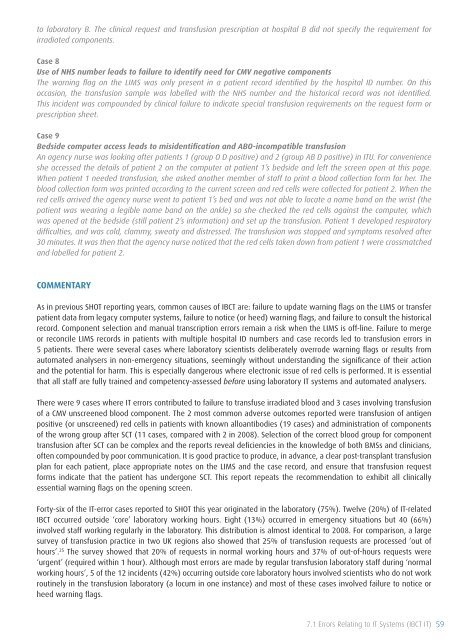SHOT Annual Report 2009 - Serious Hazards of Transfusion
SHOT Annual Report 2009 - Serious Hazards of Transfusion
SHOT Annual Report 2009 - Serious Hazards of Transfusion
You also want an ePaper? Increase the reach of your titles
YUMPU automatically turns print PDFs into web optimized ePapers that Google loves.
to laboratory B. The clinical request and transfusion prescription at hospital B did not specify the requirement for<br />
irradiated components.<br />
Case 8<br />
Use <strong>of</strong> NHS number leads to failure to identify need for CMV negative components<br />
The warning flag on the LIMS was only present in a patient record identified by the hospital ID number. On this<br />
occasion, the transfusion sample was labelled with the NHS number and the historical record was not identified.<br />
This incident was compounded by clinical failure to indicate special transfusion requirements on the request form or<br />
prescription sheet.<br />
Case 9<br />
Bedside computer access leads to misidentification and ABO-incompatible transfusion<br />
An agency nurse was looking after patients 1 (group O D positive) and 2 (group AB D positive) in ITU. For convenience<br />
she accessed the details <strong>of</strong> patient 2 on the computer at patient 1’s bedside and left the screen open at this page.<br />
When patient 1 needed transfusion, she asked another member <strong>of</strong> staff to print a blood collection form for her. The<br />
blood collection form was printed according to the current screen and red cells were collected for patient 2. When the<br />
red cells arrived the agency nurse went to patient 1’s bed and was not able to locate a name band on the wrist (the<br />
patient was wearing a legible name band on the ankle) so she checked the red cells against the computer, which<br />
was opened at the bedside (still patient 2’s information) and set up the transfusion. Patient 1 developed respiratory<br />
difficulties, and was cold, clammy, sweaty and distressed. The transfusion was stopped and symptoms resolved after<br />
30 minutes. It was then that the agency nurse noticed that the red cells taken down from patient 1 were crossmatched<br />
and labelled for patient 2.<br />
COMMENTARY<br />
As in previous <strong>SHOT</strong> reporting years, common causes <strong>of</strong> IBCT are: failure to update warning flags on the LIMS or transfer<br />
patient data from legacy computer systems, failure to notice (or heed) warning flags, and failure to consult the historical<br />
record. Component selection and manual transcription errors remain a risk when the LIMS is <strong>of</strong>f-line. Failure to merge<br />
or reconcile LIMS records in patients with multiple hospital ID numbers and case records led to transfusion errors in<br />
5 patients. There were several cases where laboratory scientists deliberately overrode warning flags or results from<br />
automated analysers in non-emergency situations, seemingly without understanding the significance <strong>of</strong> their action<br />
and the potential for harm. This is especially dangerous where electronic issue <strong>of</strong> red cells is performed. It is essential<br />
that all staff are fully trained and competency-assessed before using laboratory IT systems and automated analysers.<br />
There were 9 cases where IT errors contributed to failure to transfuse irradiated blood and 3 cases involving transfusion<br />
<strong>of</strong> a CMV unscreened blood component. The 2 most common adverse outcomes reported were transfusion <strong>of</strong> antigen<br />
positive (or unscreened) red cells in patients with known alloantibodies (19 cases) and administration <strong>of</strong> components<br />
<strong>of</strong> the wrong group after SCT (11 cases, compared with 2 in 2008). Selection <strong>of</strong> the correct blood group for component<br />
transfusion after SCT can be complex and the reports reveal deficiencies in the knowledge <strong>of</strong> both BMSs and clinicians,<br />
<strong>of</strong>ten compounded by poor communication. It is good practice to produce, in advance, a clear post-transplant transfusion<br />
plan for each patient, place appropriate notes on the LIMS and the case record, and ensure that transfusion request<br />
forms indicate that the patient has undergone SCT. This report repeats the recommendation to exhibit all clinically<br />
essential warning flags on the opening screen.<br />
Forty-six <strong>of</strong> the IT-error cases reported to <strong>SHOT</strong> this year originated in the laboratory (75%). Twelve (20%) <strong>of</strong> IT-related<br />
IBCT occurred outside ‘core’ laboratory working hours. Eight (13%) occurred in emergency situations but 40 (66%)<br />
involved staff working regularly in the laboratory. This distribution is almost identical to 2008. For comparison, a large<br />
survey <strong>of</strong> transfusion practice in two UK regions also showed that 25% <strong>of</strong> transfusion requests are processed ‘out <strong>of</strong><br />
hours’. 25 The survey showed that 20% <strong>of</strong> requests in normal working hours and 37% <strong>of</strong> out-<strong>of</strong>-hours requests were<br />
‘urgent’ (required within 1 hour). Although most errors are made by regular transfusion laboratory staff during ‘normal<br />
working hours’, 5 <strong>of</strong> the 12 incidents (42%) occurring outside core laboratory hours involved scientists who do not work<br />
routinely in the transfusion laboratory (a locum in one instance) and most <strong>of</strong> these cases involved failure to notice or<br />
heed warning flags.<br />
7.1 Errors Relating to IT Systems (IBCT IT) 59












